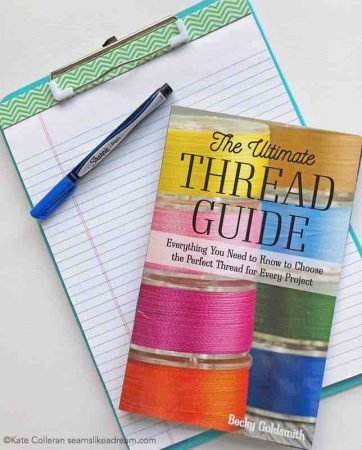Hi friends!
Different Types of Sewing Thread
In a post last week, I talked about choosing the right size sewing machine needle for your project. Today let’s talk about choosing the right sewing thread.
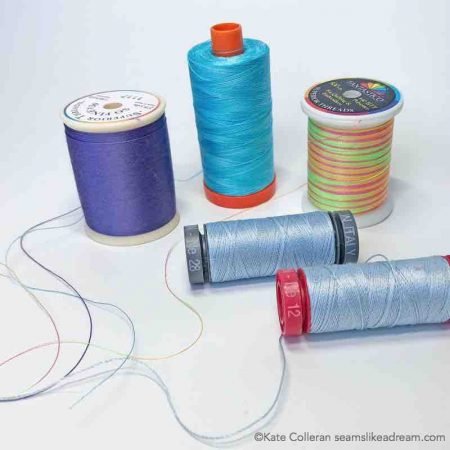
Which do you choose first – the needle or the thread? The needle size you should use is determined by the fabric and the project- am I using cotton fabric or denim? Am I piecing, machine stitching down fusible appliqué or quilting? Once you know the needle size, then it is time to pick the right thread.
Of course, if I am deciding on a quilting thread, I may have to wait to choose my needle until I have chosen my thread. Because there is more than just color in question- it is what thread fiber, what thread weight and what look you want!
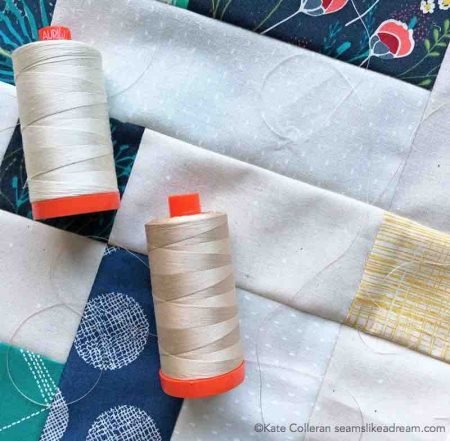
But, just like needles, the first step in choosing the right thread is to understand thread and what different types of sewing thread are available. We need to know what the information on thread fiber content, thread size (or weight) means and how to use that information to decide which type of thread to use for your project.
Different Types of Sewing Threads: Thread Fibers
Thread is made from many different types of fibers. We can break the fibers down into 2 main categories, natural and synthetic. Examples of natural fibers would be cotton, wool, and silk. Some examples of synthetic fibers would be polyester, metallics and nylon. Each fiber type has it’s uses, it’s enthusiasts and it’s detractors!
When choosing a thread you also need to think about how you plan to use the thread. Will you be machine quilting and you want the thread to show or machine quilting and you want the thread to blend in? Are you machine piecing cotton fabrics or fleece? Are you doing machine embroidery?
The thread weight will also affect your decision on what thread to use for your project.
Different Types of Sewing Threads: Thread Weight
Thread sizes are based on the weight of thread. There are different formulas used and it can get confusing but the basic idea is the weight is related to the thickness of thread. And while the exact thickness is not consistent between manufacturers, it is a good indicator of size.

Thread weights are generally listed as 50wt, 40wt, 30wt, etc and usually range from 12 to 100. The other number often listed is the ply. Ply is made up of stands of thread and the number means how many plys were used in making the thread. So you might see a 50/2 which means a 50 wt thread with 2 strands woven together. Ply can also affect the strength of the thread as well as the thickness the thread has. Generally, a 2 ply thread is thinner and lays flatter than a 3 ply.
What do the weights mean as far as thickness? Well, the scale for threads goes down (as opposed to needles which goes up!). So a 50 wt thread is thinner than a 40 wt thread. And a 40 wt is thinner than a 12 wt.
You always want to match the needle size with the thread. What that means is a thin needle needs to be matched with a thin thread. Mismatched needle size and thread can lead to lots of frustration!
Needles and Thread
Once we have chosen our fabric and the right size needle for our project, then we can chose the right thread. A basic guide is the smaller the needle, the thinner the thread! So for example, an 80/12 needle, you might want a 50 wt thread. For a 70/10 needle, you might want to try a thinner thread like a 60 wt or an 80 wt. Or if you are using a 90/14 needle for your project, you might want to use a 40 wt or even a 30 or 28 wt.
Visit the different thread companies websites and find their guidelines for their threads and this will help you determine the right thread for your project.
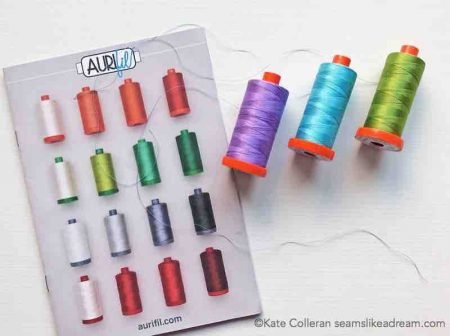
Here is a link to the Aurifil thread guide and here is a link to the Superior thread selection guide.
Another great resource is the book, The Ultimate Thread Guide by Becky Goldsmith of Piece O’ Cake Designs published by C&T Publishing. I was given the book by C&T to see if it would help me when I was researching for the guild demo that I did last week on Needles and Thread. It was very helpful!
In her book Becky tells you all about thread, including a lot of information on weight and the different ways to determine a thread’s weight, about fibers and their uses and recommendations. In the second half of the book, she has charts listing different threads by manufacturer and their uses and needle pairings. It is a great book and a handy way to have the information easily available.
Different Types of Sewing Threads: Thread Wind
Threads are wound 2 different ways. In one way the threads are wound in a way called stacked (or straight) and others are cross wound. The blue thread in the image below is cross wound and the bright thread is stacked.
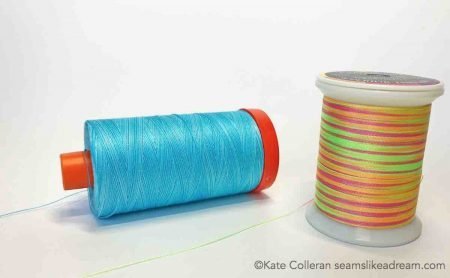
Thread that is stacked should be vertical on your machine so the thread comes off the side. Thread that is cross wound should be horizontal on your machine so the thread comes off the top.
Care and Feeding of your Thread
I love my thread collection! Those colorful spools of fiber are so pretty. Thread sitting on a shelf, in a bin or on a wooden thread holder, they are like your own little piece of art.
And, if you can’t already tell, I love my Aurifil thread! The 50wt is my go to thread for piecing my quilts; I usually use a light beige or light grey depending on the project.
Take care of your thread and think about sunlight, dust and humidity. All of these things can be damaging to your thread. Think about these when you store your thread and:
- store away from direct sunlight.
- store in a way to keep dust from collecting on your spools.
- store in an area where you can keep the humidity controlled.
- don’t use old thread. Old thread is… well, it is old! And therefore it may not be in good condition; it may break easily or throw off lots of fluff and fiber into your machine.
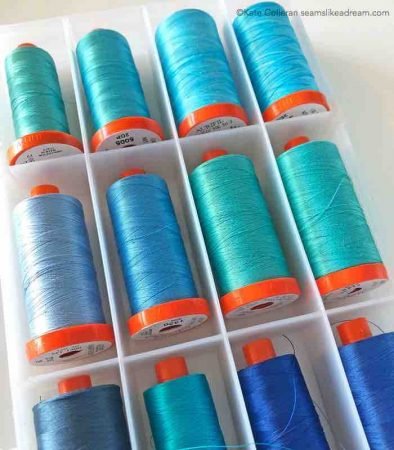
I store my thread in bins; it is very dry here in Colorado so the dust gets everywhere! Keeping them in bins keeps the dust down and I can even group them by color!
Troubleshooting
We went over this in the blog post on needles but remember, when we don’t pay attention to the needle and the thread we are using, we can experience some issues while we piece or quilt. The rule of thumb is to change your needle at the start of a new project or every 8 hours of sewing.
So if you are having issues, ask yourself, when did I last change that needle???
Here is what happens when your thread and needle are mismatched:
If your needle is too small, you may experience:
- The threads breaks on a regular basis.
- The needle breaks.
- The stitches are not even and are irregular or crooked.
If your needle is too large, you may experience:
- The fabric puckers.
- The fabric is damaged.
- There are skipped stitches.
I hope you found this information on the different types of sewing threads helpful and for those who want some of this this content as a handy PDF that you can download and save to your computer, click here to sign up for my newsletter and get my free PDF guide to Needles and Thread!
happy quilting!
Kate
Disclosure: Some of the links in this thread post are affiliate links, meaning – at no additional cost to you – I will earn a commission if you click through and make a purchase.
And while I was given the The Ultimate Thread Guide by Becky Goldsmith to review, all opinions are my own and not influenced by receiving the book. You can click the link below to shop the book.
